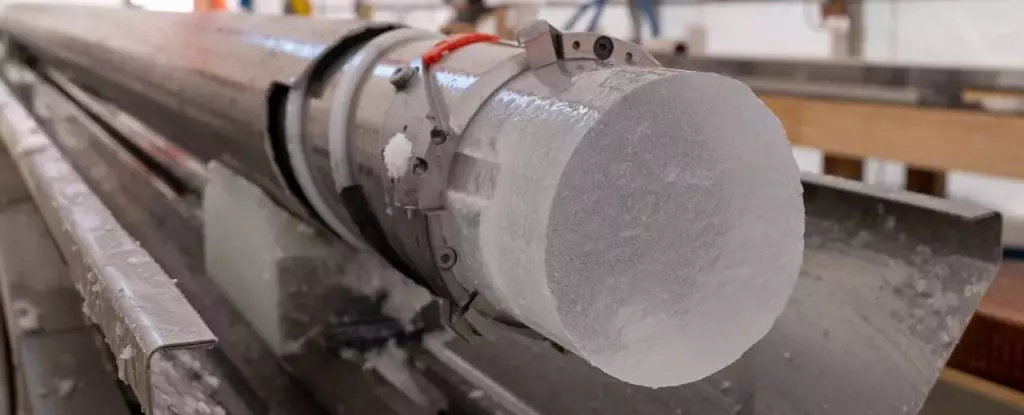In a groundbreaking endeavor, scientists have drilled a monumental ice core sample in Antarctica, potentially uncovering the oldest continuous timeline of Earth’s climate that stretches back over a million years. This colossal core, measuring an impressive 2,800 meters (9,186 feet) in length, contains meticulously preserved records of ancient atmospheric conditions. Much like how tree rings reveal the age and health of trees, ice cores offer invaluable insights into climatic shifts, atmospheric compositions, and even the resilience of life during past geological epochs. The implications of this new exploration go far beyond mere curiosity, shedding light on our contemporary climate crisis by providing a historical context that is as urgent as it is enlightening.
The core contains segments that encapsulate roughly 13,000 years of Earth’s history for every meter, revealing not just temperature fluctuations but also encapsulated air bubbles that capture atmospheric gas concentrations, such as carbon dioxide and methane. This unprecedented access to ancient atmospheric conditions allows scientists to reconstruct the climatic narrative of our planet, offering invaluable data necessary for understanding current environmental changes. Chief scientist Julien Westhoff indicated that the core could provide an uninterrupted climate record extending back 1.2 million years, with potential further analysis suggesting even older ice may lie beneath the surface, possibly dating back to the pre-Quaternary period, over 2.5 million years ago.
Deep ice cores are not merely relics; they are historical archives containing vital information about Earth’s past climate dynamics. Previous records had yielded substantial insights until now, focusing largely on the last 740,000 years. The new core data could pivotally illuminate periods when Earth underwent significant glacial cycles, especially between 900,000 and 1.2 million years ago—a time that some suspect may have seen dramatic population declines among early humanoids due to extreme climatic conditions. The challenges facing early human ancestors resonate eerily with contemporary issues stemming from climate change, underscoring how extreme weather can disrupt life.
Insights into Anthropogenic Impact
The findings from the new drilling at East Antarctica are likely to astonish both climatologists and policymakers alike. Carlo Barbante, director of EPICA, expressed that understanding the interplay between greenhouse gases and global temperatures over extensive periods could reshape our response strategies to climate change. The likelihood that modern anthropogenic emissions have skewed the natural cycles of glaciation may become clearer as more data emerges from the workings of the ice core analysis. These revelations could either ratify existing worries about climate disruption or present a more nuanced understanding of how Earth’s cycles have ebbed and flowed despite natural and human influences.
The Challenges of Conducting Research in Extreme Conditions
Conducting research in the harsh environments of Antarctica poses significant logistic challenges. The drilling site known as Little Dome C was selected due to radar surveys indicating thick, layered ice, unexposed to melting. Yet, the conditions remain daunting—with summer temperatures hovering around -35 ºC (-31 ºF). It required a multidisciplinary team and about 20 days to transport all necessary equipment to the site, illustrating the dedication and perseverance of the researchers involved. Incredibly, the isotopic analysis system employed allowed scientists to track changes in glacial and interglacial cycles in real time, demonstrating the sophistication of modern research techniques that complement an otherwise grueling fieldwork.
As research continues, experts remain optimistic about the new avenues of understanding the ice core promises to open. Climate scientist Richard Alley has described the findings as “truly, truly, amazingly fantastic,” reiterating confidence in the team’s upcoming analyses. Such research not only broadens our knowledge of ancient climatic events but also allows us to reflect on the broader implications for contemporary society. The multilayered insights gained from these ice cores seal a narrative about survival, resilience, and adaptation amidst ongoing climatic changes.
The investigation of Antarctica’s ancient ice cores stands as a testament to human curiosity and determination in the face of nature’s vast complexities. The stories embedded in these frozen layers not only offer a window into Earth’s climatic past but also hold critical lessons for humanity’s future. By comprehensively analyzing the intricate dynamics between greenhouse gases and climate patterns, scientists can better equip society to confront the challenges posed by modern climate change, ensuring that the lessons gleaned from the past serve as guiding beacons for a sustainable and informed future.

Leave a Reply